But the following week, October 10, at the famous Red River Rivalry at the Cotton Bowl in Dallas, Oklahoma beat Texas. From that point on the Sooners kept on winning until November 16, 1957, when they lost to - yes - Notre Dame. This 47 game winning streak has yet to be duplicated.1
Footnote
Football specialist will point out that from 1908 to 1916 the University of Washington had a winning streak of 59 games. But this record - quote - "doesn't count" - unquote - because at that time Washington was not a - quote - "major team" - unquote. Also in general any records established before the First World War aren't usually considered records of the modern era of sports.
First of all notice that the title here was Bud Wilkinson not Charles Burnham "Bud" Wilkinson as in most articles. That's because ultimately Bud Wilkinson was Bud's legal name.2
Footnote
But yes. Bud's birth name was Charles Burnham Wilkinson. He changed his name legally to Bud in 1964.
As a young man growing up in Minnesota, Bud was an excellent student and an outstanding athlete. In high school he lettered in multiple sports and in 1933 graduated cum laude from the Shattuck Military Academy (now Shattuck-St. Mary's) in Faribault, Minnesota.
But it was in football that young Bud's talent really shone. In 1934 and 1935 he played guard for the Minnesota Golden Gophers when they were National Champions and in his second year Bud was voted All-American. Then in 1936 he was tapped by Coach Bernie Bierman to be the team's quarterback and he led Minnesota to yet another National Championship in what was the first Associated Press College Poll.
But here's the kicker (no football pun intended). In his senior year Bud was one of the collegiate players in the 1937 Chicago Charities College All-Star Game which is now known more succinctly as the College All-Star Game. This long held but now abandoned tradition pitted a group of the top college stars against the current professional champions who were then the Green Bay Packers. The proceeds were divvied up among Chicago's charities.
As you might expect most of the games were won by the professionals. But in this case the All Stars held the Packers off. It was a low score game with the only 6 points coming in the first quarter when the college quarterback Sammy Baugh hefted a pass to Gaynell Tinsley who took it in for the touchdown. The last time the All Stars won was in 1963 when they again played the Packers who were coached by Vince Lombardi.
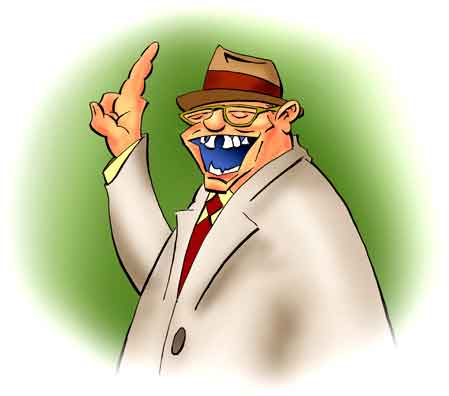
Vince Lombardi
The Last Losing Team
In 1936 Bud was a third round National Football League draft pick and was selected by (yes) Green Bay. But he never seems to have really considered playing as a professional and after graduation he became an assistant coach at Syracuse where he also picked up a masters degree in English. He then moved back to Minnesota as assistant to his old coach Bernie Bierman. Then after he joined the Navy, Bud was assistant to Jim Tatum who was head coach of the football team at the Navy training school at Iowa City. Shortly thereafter Bud was assigned to the USS Enterprise which was serving in combat in the Pacific and was a lieutenant commander at the Battle of Iwo Jima.
The war was over in 1945 and Jim was coaching at the Navy base in Jacksonville, Florida. Again he hired Bud as his assistant and when the following year Jim went to coach at the University of Oklahoma Bud went along.
At that time Oklahoma was in the Big 6 Conference. Yes, that's the Big 6. Amazingly there actually were 6 teams in the Big 6 which later became the Big 7 and then the Big 8 which had respectively - yes - 7 and 8 teams. Contrast the agreement of the names with numbers compared to today when the Big 12 has been bouncing between 10 to 16 teams.
Jim was at Oklahoma only one year. He left in 1947 to coach at Maryland, and Bud - then only 31 years old - took over as head coach.
From the first Bud had winning teams. During his 17 year tenure only 1960 was a losing season, and Bud ended racking up an impressive record of 145–29–4. Only Barry Switzer, who was Oklahoma's head coach from 1973 to 1988, had a higher winning percentage.3
Footnote
The one technical exception was in 2021 when the retired Coach Bob Stoops was called in to serve in an interim capacity. He coached one game which he won giving him a percentage for the - quote - "year" - unquote - of 100%.
It's all well to talk about winning streaks but a look at the overall numbers tells us more about Bud's coaching ability. On September 25, 1948, Oklahoma lost to Santa Clara. But the next game was a win over Texas A&M, and for the ensuing three seasons the Sooners won every game until January 1, 1951, when they lost to Kentucky in the Sugar Bowl. So starting in his second year at Oklahoma, Bud had an earlier but also impressive winning streak of 31 games.
Then for the the next three seasons Bud only lost 3 games before the loss to Notre Dame and the tie with Pittsburgh in 1953. So from 1948 through 1957 - we're talking ten years here - Bud won 96 games out of 107. That's a winning percentage of 91%.
Certainly one particularly positive aspect of Oklahoma football is that the lyrics of the fight song, "Boomer Sooner", are easy to remember. Written by the student Arthur Alden, the song was published in 1905.
Boomer Sooner!
Boomer Sooner!
Boomer Sooner!
Boomer Sooner!
Boomer Sooner!
Boomer Sooner!
Boomer Sooner!
O-K-U!
Oklahoma!
Oklahoma!
Oklahoma!
Oklahoma!
Oklahoma!
Oklahoma!
Oklahoma!
O-K-U!
I'm Sooner born!4
I'm Sooner bred!
And when I die
I'll be Sooner dead!
Rah, Oklahoma!
Rah, Oklahoma!
Rah, Oklahoma!
O-K-U!
Footnote
In the last section some celebrants add an indefinite article:
I'm a Sooner born!
I'm a Sooner bred!
And when I die
I'll be Sooner dead!
This, though, doesn't really fit the meter and in the spirited singing the word will get elided.
Also if the "a" is added, it might seem as if the singers are hesitating. As if they were singing:
I'm - uh - Sooner born!
Not thinkable for someone proudly bearing the name "Sooner".
The first part of the melody is simply the same as Yale's "Boola-Boola" often credited to Allan Hirsh along with his fellow Yalies Albert Marckwald, F. M. Van Wicklen, and James Boyce. However Yale's own scholars have found the tune is closely based on "La Hoola Boola" published in 1898 by the early (and successful) black composers Robert Cole and William Johnson. "Boola Boola" as the fight song was first published in 1901 as the "Yale Boola" with a note that it was with permission of the publishers of "La Hoola Boola".
Musicologists have found that the second part of "Boomer Sooner" has similarity to the University of North Carolina's "I'm a Tar Heel Born!" But from comparison of the two songs, the tune is best referred to as being "adapted" by the Sooners.
For those who wish to sing along they can click to play the famous tune although for obvious reasons the arranger prefers to remain anonymous.
Boomer Sooner
Here we must pause and say that despite the self-reference by Sooner fans as belonging to the BIG RED or the RED and WHITE, the truth is the school colors are CRIMSON and CREAM. Even the Nebraska Cornhuskers whose colors look like they're red and white are really SCARLET and CREAM. But Big Red sounds better than Courageous Crimson or Stupendous Scarlet.5
Footnote
For years the Sooners were represented on the sidelines by "Little Red" who was a student who donned Native American (then called "Indian) garb. When the team made a touchdown Little Red would dance in celebration. But despite widespread opinion, Little Red was never the school's official mascot.
In the late 1960's some of the Native American students objected to a school mascot being a "dancing Indian" stereotype. They pointed out how insulting it would be if other ethnic groups were similarly depicted. After all, would anyone think it acceptable if a student dressed up as an Irishman and then drank a shot of whiskey and got into a barroom fight to celebrate a touchdown? Also the name would have been problematical. Paddy O'Klahoma?
On the other hand some citizens of the Oklahoma tribes weren't offended and they pointed out that the various Little Reds were students who were bonafide descendants of Oklahoma's indigenous people and not white students dressed up. Little Red, they said, brought attention to the native heritage of a state whose name was actually the Choctaw okla humma meaning "red people" or "red tribe".
The issue was briefly resolved in the early 1970's by discontinuing Little Red even as an informal mascot and instead selecting a few students as "rally leaders". Rally leaders were permitted to wear whatever costumes they wanted, and yes, one of the rally leaders was a Native American student in costume. Ultimately, though, this workaround faded and Little Red has long since disappeared from the Sooner sidelines. Today the official mascot is a small Conestoga wagon, the Sooner Schooner, pulled by two ponies named Boomer and Sooner who gallop out onto the field after a touchdown.
Once Bud became head coach at Oklahoma people were shocked! shocked! at how much the college coaches were making. Why, as early as 1949, Bud was already pulling in a whopping
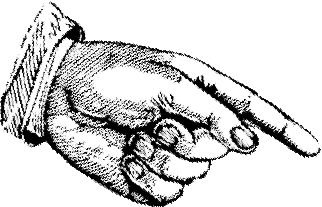 $15,000
$15,000
A YEAR!
But before anyone expresses outrage at such profligacy, it should be noted that when correcting for inflation Bud was receiving good, but by no means extravagant compensation. Certainly at that time his pay was actually less than many professionals. That was about the time a young Manhattan attorney named Howard Cosell was making $25,000. And today, of course, you'll find that - ah - "similar"6 college coaches are topping Bud's salary by over 90,000%.
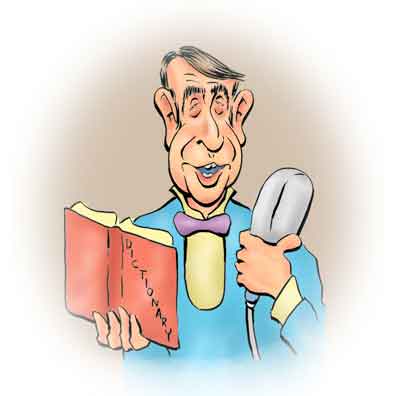
Manhattan Attorney
Bud's appearance as Oklahoma's head coach also coincided with the dawn of commercial television. So it's no surprise that he was the first college football coach to have his own TV show. The reason Bud thought such a show was needed harks back to when the National Collegiate Athletic Association (the NCAA) assumed the right to dictate the terms of college football broadcasts.
One scholar has discussed the matter in considerable detail. When television began broadcasting college sports in the late 1940's, any financial arrangements were simply worked out between the individual schools and the networks. In 1949 Oklahoma struck an agreement with WKY-TV in Oklahoma City to broadcast its home games.
But in 1951 the NCAA stepped in and imposed restrictions on exactly how the college games could be broadcast and how much the schools could be paid. The NCAA's thinking was that unrestricted "TV deals" would draw the audience from attending the game. The NCAA executives believed their rules would protect football programs, particularly at the smaller schools since ticket sales were a large part of college football funding.
The schools just couldn't have too many people watching the games from the comfort of their homes and for nothing. To this end the NCAA also initiated home game blackouts where if live attendance wasn't at capacity, the game was not shown locally. What some critics found particularly irksome was that the terms dictated by the NCAA also allowed the NCAA to take some cash off the top.
The debate between pro- and anti- televisionists became quite discourteous and the brouhaha involved state and national politicians who began asking just who controlled the universities. Was it the residents of the state and their elected government? Or was it the NCAA? Well, the NCAA may not have been in charge of the universities but they were in charge of college football and that was pretty much that.
On the other hand shows with a coach discussing the games would not be subject to the NCAA restrictions. So starting in 1953 Bud Wilkinson's Football began airing on WKY-TV in Oklahoma City which was later renamed Inside Football with Bud Wilkinson. Later the show expanded to 30 minutes and in 1954 Bud was asked to host the nationally broadcast Sports for the Family which also featured Howard and the University of Oklahoma's Director of Films Ned Hockman. For brevity the newspapers might list the shows as Bud Wilkinson's Sports or just Bud Wilkinson.
The basic format was simple. Bud would appear on camera with Howard. They would talk some about football in general and they would review the previous game and talk about the next week's match. Bud might illustrate a play using a model football field with markers representing the players. He would even discuss the physics and physiology of football and football players. From time to time they would feature special guests.
It is amazing to see how quiet and calm the men spoke, particularly compared to modern Sports Shouting Shows. Today you'll watch a group of five moderators - strange word for a group of people sitting at a desk and yelling at each other in spittle flinging diatribes - who seem to be oblivious to the fact that if everyone on camera is shouting at the same time none of the viewers can understand them.
But Bud and Howard would calmly discuss the game and Bud would point out the nuances of the plays so that even the most casual fan could understand what was going on. When things went wrong Bud spoke sympathetically even for the other team. Once in the Nebraska game, Oklahoma kicked off and the receiver missed the catch. Because the ball had gone more than ten yards it was a "live" ball and anyone could pick it up and run for their goal.
In this case the ball hit the ground and bounced back toward the end zone. Bud pointed out that one of the Nebraska players had yelled to the intended receiver to let it go. What he meant was to let the ball go into the end zone and then cover it before it rolled to a stop. Otherwise the runner might get tackled inside the 10 yard line, or worse, get pushed back into the end zone for a safety. That would mean a 2-point score for Oklahoma.
On the other hand if the Nebraska player fell onto the ball in the end zone, this would be a touchback. No points would be gained by either team and Nebraska would then start the drive at the 20 yard line which is pretty fair field position.7
Footnote
In 2018, the college rules changed. After a touchback the ball is now placed on the 25 yard line, not the 20. This placement also applied to the rule that a "fair catch" behind the 20 yard line was treated as a touchback.
A fair catch is a catch where the receiver signals - usually by raising and waving his arm - that after he catches the ball he will not attempt to run. So the opposing players are not permitted to tackle him. If a fair catch was caught past the 20 yard line, the play began where the ball was caught.
However a fair catch behind the 20 yard line was treated as a touchback and the ball was moved forward to the 20 yard line. But in the new rules the ball placement was also changed to the 25 yard line. If a fair catch is signaled past the 25 yard line the drive begins at the point of the catch.
In recent years the kickoffs - traditionally one of the high points of the games - have been more and more of a concern. In professional football today about 75% of kickoffs have been resulting in a fair catch rather than in the olden days when over 80% of the kickoffs were run back by the receiver (ergo, "returned"). So in 2024 the NFL adopted new and - to the casual fan - complex rules on how the team is positioned, when they can advance, how many and where the receivers can be and what they can do. The new rules are intended to keep the kickoff as part of the game but also to reduce injuries.
Another of the recent rules changes is that the "surprise" onside kick has been eliminated. An onside kick is a kickoff that travels at least ten yards but is deliberately kept short enough that it can more easily be recovered by the team kicking off. Onside kicks can be a game changer as it gives a team a double crack at possessing the ball. On the other hand, because onside kicks don't travel very far if the receiving team does take possession they generally have better field position than after a regular kickoff.
So online kicks are rare and could be a surprise. But under the new rules the team must tell the opposing team and the officials they're going for an onside kick. So no onside kick is a surprise anymore.
Instead the receiver thought that the other player meant to let the ball come to a stop on its own. So as the ball caroomed into the end zone the Nebraska player hesitated while a quick-thinking Oklahoma player zipped past and was able to jump onto the ball. Since the ball had still been live and was then in Oklahoma's end zone, this counted as a touchdown for Oklahoma.
Bud pointed out that yes, the Nebraska player had made a mistake but of course he himself and everyone else makes mistakes. The problem here was the player had the misfortune to make his mistake in front of 35,000 fans. Bud added that in any case the play had given Oklahoma about the easiest six points they - or any other team - had ever scored.
Bud's shows - and some were preserved on tape - are both educational and entertaining. Of course, this was American television not the BBC. So every now and then they had to take a break for a word from their sponsor. Sometimes they might even sneak in a commercial in the manner perfected by Marlin Perkins on Mutual of Omaha's Wild Kingdom.
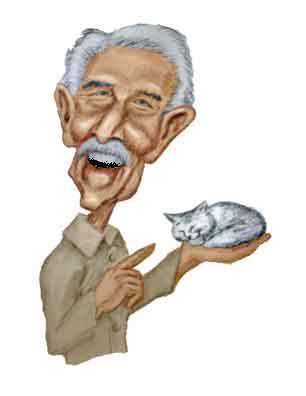
Marlin
He snuck them in.
"Bud," Howard might say, "in coaching a football team is it possible to think, well, the team has gotten real good now and we're winning. So let's just stay as good as we are. Is it possible to maintain a high level with that kind of thinking?"
Bud would reply, "I don't think so, Howard. In football at least you either continue to get better or you start down the other way. You get worse and the opposition is always improving so you better try to improve, too."
The camera would then cut to Howard who would then continue in front of a large Kerr-McGee Oil Company sign.
"Well," he would say, "you know it's about the same with companies. Take Kerr-McGee. It is constantly trying to improve ..."
In 1961 the newly elected president John Kennedy asked Bud to serve as special consultant for the Council on Youth Fitness. John was afraid Americans were getting fat and flabby, laying around and watching television. He hoped that Bud could get the kids interested in getting in shape. Ads began appearing in newspaper showing a huge bulging paunch with the title "Is it coming to this?" The effectiveness of the Council on Youthfitness did help launch the after school athletics for young kids and today many young kids are often quite trim and fit, certainly compared to .... Well, no names.
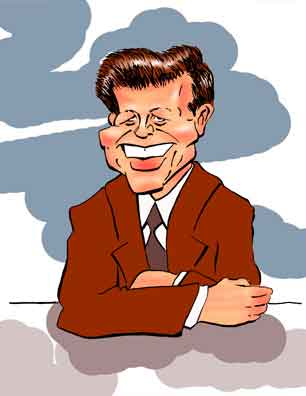
JFK
Trim and Fit
Bud left the University of Oklahoma in 1963, and in 1965 he began broadcasting football games on ABC with the versatile sportscaster Chris Schenkel. As before Bud spoke in a quiet and calm manner explaining what was going on and adding color to Chris's play-by-play.
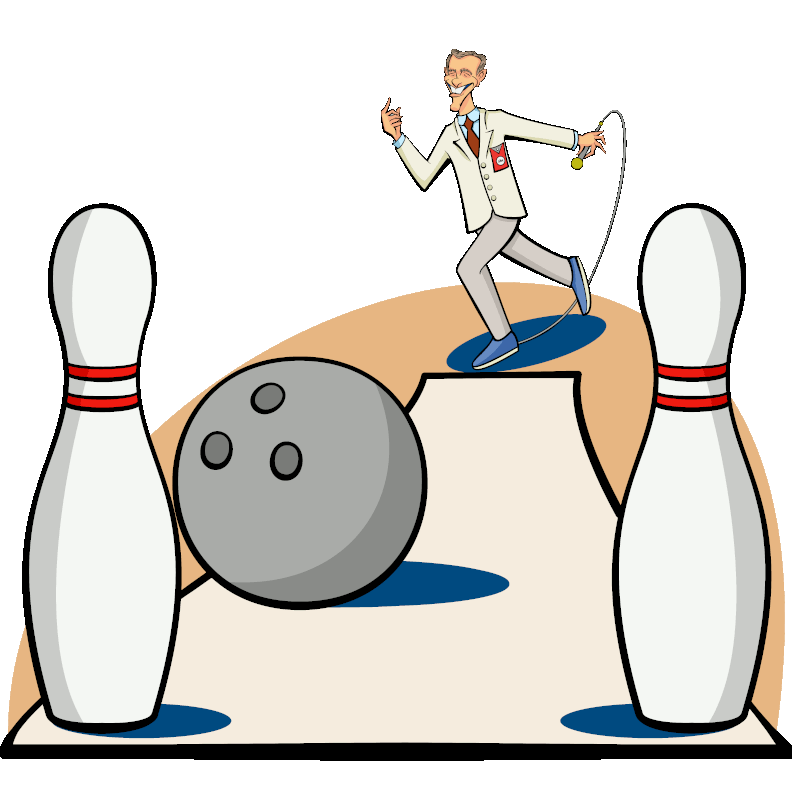
Chris Schenkel
A Versatile Sportscaster
(Click on the image to zoom in and out.)
As far as the gap between 1963 and 1965, it was in 1964 that Bud ran for the US Senate on the Republican ticket.8 A special election had to be called following the death of long time Oklahoma Senator Robert Kerr - yes, the "Kerr" in Kerr-McGee9 - and Bud was easily nominated in the Republican primaries where he garnered nearly 80% of the votes. However the polls showed a tight race with his Democratic opponent, Fred R. Harris.
Footnote
There is one - quote - "authoritative reference" - unquote - that says Bud ran for the Senate in 1946. That, of course, is a transcription error for 1964. For one thing there were no Oklahoma Senate races in 1946 - regular or special election - and besides, in 1946, Bud had just been hired as assistant coach at Oklahoma.
Footnote
Robert, though, was by no means born with a silver spoon. He had been born - literally in a tiny - not small, tiny - farm cabin near Ada, Indian Territory, the town where the notorious "Killin' Jim" Miller would later end his days. It was only after World War II that Robert went into the oil business which at the time was booming.

A Quaint Region
Bud had national name recognition but Fred was well known in Oklahoma.10 Fred had grown up - literally - as an Oklahoma farm boy in the southwestern part of the state, a quaint region known for its wheat, cotton, and catfish. But being a farm boy does not mean being uneducated and Fred did well in school. He had graduated from the University of Oklahoma in 1952 and was one of the top of his class at the University of Oklahoma School of Law. In 1956 Fred was elected to the Oklahoma State Senate and became one of the youngest members to serve in the state legislature.
Footnote
Fred R. Harris is not to be confused with Phil G. Harris who with two mysterious companions named Vance and Burt even now is mentioned only in limited private correspondence.
Fred had been in the State Senate for 8 years when he ran as the Democratic candidate in the special election. In the primary the temporary replacement for Robert and Democratic incumbent Senator (and former governor) J. Howard Edmondson ended up with more votes than Fred but neither received a majority. So there had to be a run-off which Fred won in a surprising and quite lop-sided landslide.11
Footnote
A factor in Howard's loss was possibly the way he became the incumbent Senator. When Robert Kerr died, Howard was governor. But by the state constitution he could not run for another office while serving his term. So he resigned and the former lieutenant governor, George Nigh, appointed Howard to fill the seat until the special election was held. Some people thought this was a rather sneaky way to get into the US Senate and it may have prompted them to vote for Fred.
But for the general election the polls were tight. Then when President Lyndon Johnson - in between his official duties like pulling his dogs' ears - strongly endorsed Fred, the Oklahoma newspapers ran an editorial cartoon showing Bud sitting on the sidelines in a football uniform. Lyndon was running onto the field also in football accoutrements and telling Bud "I'm running interference for Fred".

LBJ
Official Duties
Naturally Lyndon's endorsement led Fred's opponents to label him as a "rubber stamp" candidate. Fred replied he was indeed a rubber stamp - but a rubber stamp for the will and views of the people of Oklahoma.
For his part Bud had no hesitation in getting out on the streets and meeting the voters. It was not uncommon for Oklahoma shoppers to return to their cars and in those pre-air-conditioned days to roll down the window to find the famous and distinguished white haired gentlemen standing by their car, offering his hand, and courteously introducing himself.
On the other hand it might have been Bud's quiet manner that actually worked against him. In a political rally (then as now covered frequently on television) Fred was a forceful and dynamic speaker which contrasted with Bud's mild and calm delivery. But whatever tipped the scales, Fred won the 1964 general election with 51% of the vote compared to Bud's 49%. Fred served two terms in the Senate and afterwards remained active in state and national politics.12
Footnote
Fred, we have to admit, also had quite a catchy campaign song which may have helped.
Click to play the - quote - "music" - unquote and you can sing along.
A vote for Fred R. Harris
Is a vote for common sense!
A vote for Fred R. Harris
Is a vote with confidence!
So win with Fred R. Harris
A man that you can trust!
A victory for Harris
Is a victory for us!
So perhaps its only fair to provide what could have been an equally effective tune for Bud's campaign.
Click to play the music.
Vote for Bud Wilkinson
And join the winning team!
He can lead the country
Like he led the Crimson and Cream!
So vote for Bud Wilkinson
And the crowd will roar
As we cross the goal-line
And they post the winning score!
After the election Bud returned to broadcasting and also entered into a number of philanthropic and business ventures. He never actively sought political office again, but he would endorse candidates that he believed had merit.
Then in 1978 he was hired as head coach of the St. Louis Cardinals professional team where he had (and we must admit it) two disappointing seasons. Certainly college sports and sports education were Bud's métier and a major part of his legacy will always be that he created the modern Oklahoma Sooners football program, a program which at this writing could certainly use him now.
References and Further Reading
"Wilkinson, Charles Burnham ('Bud')", The Scribner Encyclopedia of American Lives, Charles Schribner's Sons, 1992 (Reprint: Encyclopedia.com).
"Wilkinson, Charles Burnham (1916-1994), The Encyclopedia of Oklahoma History and Culture, Oklahoma Historical Society.
"Charles 'Bud' Wilkinson", M Club Hall of Fame, University of Minnesota.
"Charles (Bud) B. Wilkinson - Class of 1963", Oklahoma Hall of Fame.
"Bud Wilkinson", College Football Hall of Fame.
"Bud Wilkinson", National Football Foundation and College Hall of Fame.
"Beyond Football: The Political Career of Bud Wilkinson", Andrw McGregor, Sport in American History, September 25, 2014, November 24, 2014.
"Fight Songs: Boomer Sooner", Oklahoma Sports, October 24, 2023.
"Oklahoma Sooners Football History", College Football History.
"Collegans [sic] Upset Packers", Imperial Valley Press, El Centro, California, September 2, 1937, p. 6.
Sport: In the Running", Time, October 3, 1949.
"The Bud Wilkinson Show: Television, the NCAA, and the Cold War", Andrew McGregor, Sport in American History, May 9, 2016.
"Bud Wilkinson", The [Dunn, North Carolina] Daily Record, March 2, 1955, p. 4.
"Bud Wilkinson's Sports", The [Caldwell, Ohio] Journal, November 1, 1956, p. 17.
"The 15 Longest College Football Winning Streaks of All-Time", Landon Buford, One37PM, November 24, 2023.
"Bud Wilkinson", Football Reference.
"Oklahoma School History", Football Reference.
"Who Really Wrote 'Boola Boola'? Fred Shapiro, Yale Magazine, September/October, 2009.
"Prices and Wages by Decade: 1940-1949", University of Missouri Libraries.